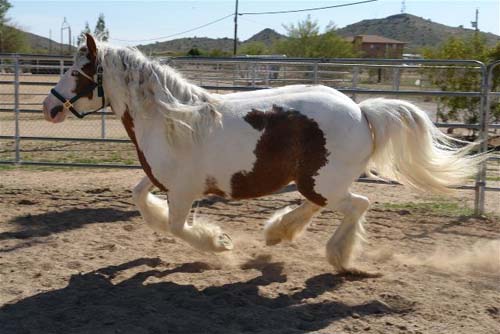
The Gypsy Vanner Horses are considered to be natives of United Kingdom and Ireland. This breed of horses is also known by many other names that include Gypsy Cob, Tinker Horse, Colored Cob and Irish Cob.
These horses are a great blend of the shire, Clydesdale, Friesian and Dales pony horses that are known to have great strengths of their own. The horses of this breed are specifically bred for their gentle nature, size and attractive colors that can match the lively colors of the gypsy vans.
The horses of the Gypsy Vanner breed are easily recognizable because of their abundance hair and feathering. The horses of this breed are fairly tall as compared to the other breeds. The average height of the Gypsy Vanner horses ranges from 14 to 17 hands. They have a powerful build which is compact too. The ribs are well sprung out and the chest is wide. They have a short body and heavy, muscular hips. They have round withers and sturdy shoulders.
The hair of the horse, for which they are known for, should be silky and also straight. The legs have a good bone structure and the hooves are big. These horses are well known for their endurance levels and their ability to travel over long distances without falling prey to fatigue. These animals are noted for their docility and even temperament. They are intelligent creatures that are eager to please their owners
Size
14 - 17 hands
Colours
Any coat color is acceptable for the horses of the Gypsy Vanner breed. Most of them also have pinto patterns on their coat which are acceptable.
Suitable for
These horses are used as pleasure horses. They are also used to pull wagons and caravans. They Gypsy Vanner horses also find their usage as show horses and for dressage competitions.
History
The Gypsy horses were initially bred to be able to pull wagons and caravans. The Gypsy Vanner horses gained recognition as the breed only towards the latter part of the 20th century. The details of the development of this breed are difficult to obtain because of the families treasure this secret to a great extent. Towards the end of the 20th century, registries were established in order to promote these horses due to their ever increasing popularity.
:max_bytes(150000):strip_icc():format(webp)/what-horses-eat-that-keep-them-healthy-1886504-FINAL-5ba8dd3746e0fb0025eb2cb4.png)
:max_bytes(150000):strip_icc():format(webp)/horse-eye-resized-56a4dbf03df78cf77284fe95.jpg)
:max_bytes(150000):strip_icc():format(webp)/Horse-grooming-GettyImages-495726400-5876f27d5f9b584db351222e.jpg)
:max_bytes(150000):strip_icc():format(webp)/close-up-of-hand-holding-parrot-705172843-5b52bc4ec9e77c0037b6e5a4.jpg)
:max_bytes(150000):strip_icc():format(webp)/GettyImages-579524112-5c77331146e0fb000140a3a6.jpg)
:max_bytes(150000):strip_icc():format(webp)/budgerigarsonrope-331834_1920-5b628213c9e77c00255b32bc.jpg)
:max_bytes(150000):strip_icc():format(webp)/GettyImages-106887241-58325bc03df78c6f6a9a2ed2.jpg)
:max_bytes(150000):strip_icc():format(webp)/GettyImages-878015800-06106157c9d34a2081db4abcae8699b1.jpg)
:max_bytes(150000):strip_icc():format(webp)/hungry-cat-57b72fac5f9b58cdfda11a62.jpg)


:max_bytes(150000):strip_icc():format(webp)/4374985466_59c7f6545b_o-8b4f24f2f3e544349fe537fde58cfad0.jpg)
:max_bytes(150000):strip_icc():format(webp)/GettyImages-9298737261-500c5a2fba4248f89d1c17a33bf438f7.jpg)
:max_bytes(150000):strip_icc():format(webp)/veterinarian-and-owners-examining-dog-in-vet-s-surgery-164853745-dbecbdb691d549d79487d84356920cf4.jpg)